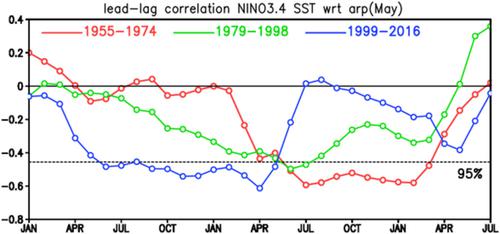当前位置:
X-MOL 学术
›
Int. J. Climatol.
›
论文详情
Our official English website, www.x-mol.net, welcomes your
feedback! (Note: you will need to create a separate account there.)
Interdecadal change in the relationship of Indochina Peninsula May precipitation to ENSO
International Journal of Climatology ( IF 3.5 ) Pub Date : 2020-12-13 , DOI: 10.1002/joc.6968 Renguang Wu 1, 2, 3 , Peijun Zhu 1
International Journal of Climatology ( IF 3.5 ) Pub Date : 2020-12-13 , DOI: 10.1002/joc.6968 Renguang Wu 1, 2, 3 , Peijun Zhu 1
Affiliation

|
The present study detected an obvious interdecadal change in the relationship of Indochina Peninsula (ICP) May precipitation to El Niño‐Southern Oscillation (ENSO). During the 1950s through the late‐1970s, more (less) ICP precipitation tends to occur in May of La Niña (El Niño) developing years, whereas after the late‐1990s, more (less) ICP precipitation tends to appear in May of La Niña (El Niño) decaying years. During the late‐1970s through the late‐1990s, more (less) ICP precipitation occurs in May of La Niña (El Niño) persisting years. The interdecadal change in the ICP May precipitation‐ENSO relationship is related to two factors. One factor is the developing time of ENSO events. During the 1950s through the late‐1970s, ENSO events develop earlier with larger equatorial central‐eastern Pacific sea surface temperature (SST) anomalies in May. SST‐induced lower‐level wind anomalies extend northwestward from the equatorial central Pacific to the ICP. After the late‐1990s, ENSO events develop later with smaller equatorial central‐eastern Pacific SST anomalies in May. SST‐induced lower‐level wind anomalies are confined to the Pacific region. The other factor is the tropical Indo‐Pacific SST anomaly pattern. During the ENSO decaying years after the late‐1990s, opposite SST anomalies in the North Indian Ocean and central North Pacific work together to induce stronger wind anomalies over the ICP in May. In contrast, during the ENSO decaying years during the 1950s through the late‐1970s, wind anomalies are weaker over the ICP in May under the sole influence of the North Indian Ocean SST anomalies.
中文翻译:

印度支那半岛5月降水与ENSO关系的年代际变化
本研究发现印度支那半岛(ICP)5月降水与厄尔尼诺-南方涛动(ENSO)之间的关系存在明显的年代际变化。在1950年代到1970年代后期,LaNiña(ElNiño)发育年的5月份倾向于出现更多(更少)的ICP降水,而在1990年代后期之后,La 5月的ICP降水倾向于更多(更少)的ICP降水。尼娜(ElNiño)衰落的年代。在1970年代后期至1990年代后期,拉尼娜(ElNiño)持续5月出现了更多(更少)ICP降水。ICP 5月降水与ENSO关系的年代际变化与两个因素有关。一个因素是ENSO事件的发展时间。在1950年代至1970年代后期,ENSO事件发展得较早,5月赤道中部-太平洋东部海表温度(SST)异常较大。SST引起的低层风异常从赤道中太平洋向西北延伸至ICP。在1990年代后期之后,ENSO事件随后在5月份随赤道中东部太平洋SST异常变小而发展。SST引起的低层风异常仅限于太平洋地区。另一个因素是热带印度太平洋SST异常模式。在1990年代后期ENSO衰减的几年中,北印度洋和北太平洋中部的相反的SST异常共同作用,在5月在ICP上引发了更强的风异常。相反,在1950年代至1970年代后期的ENSO衰减年中,在北印度洋海表温度异常的唯一影响下,5月ICP的风距平较弱。
更新日期:2020-12-13
中文翻译:

印度支那半岛5月降水与ENSO关系的年代际变化
本研究发现印度支那半岛(ICP)5月降水与厄尔尼诺-南方涛动(ENSO)之间的关系存在明显的年代际变化。在1950年代到1970年代后期,LaNiña(ElNiño)发育年的5月份倾向于出现更多(更少)的ICP降水,而在1990年代后期之后,La 5月的ICP降水倾向于更多(更少)的ICP降水。尼娜(ElNiño)衰落的年代。在1970年代后期至1990年代后期,拉尼娜(ElNiño)持续5月出现了更多(更少)ICP降水。ICP 5月降水与ENSO关系的年代际变化与两个因素有关。一个因素是ENSO事件的发展时间。在1950年代至1970年代后期,ENSO事件发展得较早,5月赤道中部-太平洋东部海表温度(SST)异常较大。SST引起的低层风异常从赤道中太平洋向西北延伸至ICP。在1990年代后期之后,ENSO事件随后在5月份随赤道中东部太平洋SST异常变小而发展。SST引起的低层风异常仅限于太平洋地区。另一个因素是热带印度太平洋SST异常模式。在1990年代后期ENSO衰减的几年中,北印度洋和北太平洋中部的相反的SST异常共同作用,在5月在ICP上引发了更强的风异常。相反,在1950年代至1970年代后期的ENSO衰减年中,在北印度洋海表温度异常的唯一影响下,5月ICP的风距平较弱。











































 京公网安备 11010802027423号
京公网安备 11010802027423号